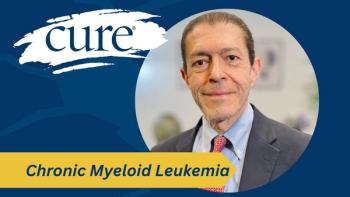
- CURE® San Antonio Breast Cancer Symposium Conference Report
Verzenio Continues to Show Reduced Risk in Invasive Disease-Free Survival in High-Risk Early HR+ Breast Cancer
In this phase 3 trial, Verzenio with endocrine therapy reduced the risk for invasive disease recurrence and death versus endocrine therapy alone for patients with high-risk, early hormone receptor–positive, HER2-negative breast cancer.
The combination of Verzenio (abemaciclib) and standard endocrine therapy showed a 28.7% reduction in the risk for invasive disease recurrence or death compared with endocrine therapy alone in patients with high-risk, early hormone receptor-positive, HER2-negative breast cancer, according to findings from an analysis of the phase 3 monarchE trial presented during the 2020 San Antonio Breast Cancer Symposium.
Specifically, results showed that, with 395 events and a median follow-up of 19 months, the invasive disease-free survival benefit was found to be clinically meaningful. The two-year invasive disease-free survival rates were 92.3% and 89.3% with Verzenio and endocrine therapy alone, respectively.
“(Verzenio) combined with standard endocrine therapy continued to demonstrate a reduction in the risk of developing (invasive disease-free survival) and distant relapse-free survival events for patients with hormone receptor-positive, HER2-negative, high-risk early breast cancer, and resulted in a statistically significant improvement in (invasive disease-free survival) in patients with high Ki-67 tumors,” senior study author Dr. Priya Rastogi, associate professor of medicine at the University of Pittsburgh School of Medicine, said in a press briefing ahead of the virtual meeting. “(Verzenio) in combination with endocrine therapy is the first CDK4/6 inhibitor to demonstrate efficacy and tolerability for (this patient population).”
Verzenio is an oral, continuously dosed CDK4/6 inhibitor that is currently approved by the Food and Drug Administration for the treatment of patients with hormone receptor-positive/HER2-negative advanced or metastatic breast cancer in combination with an NSAID, Faslodex (fulvestrant) or as monotherapy.
In the monarchE trial, patients with hormone receptor-positive/HER2-negative, node-positive, high-risk early breast cancer were enrolled into one of two cohorts: one was based on clinicopathological risk factors, which included four or more positive axillary lymph nodesor one to three axillary lymph nodes and at least a grade 3 histology or a tumor size 5 cm or larger; the second cohort was based on Ki-67 status (a measurement of how quickly cancer cells are dividing and multiplying) and comprised patients with one to three axillary lymph nodes, a centrally tested Ki-67 index of 20% or higher, no grade 3 histology and a tumor size below 5 cm. The population (5,637 patients) included patients in both cohorts.All patients were randomized to receive standard endocrine therapy for five to 10 years as clinically indicated alone or with Verzenio at 150 mg twice daily for up to two years. Patients were categorized based on prior chemotherapy, menopausal status and region.
The primary end point of the trial was invasive disease-free survival and secondary outcome measures included invasive disease-free survival in the Ki-67-high (≥20%) population (2498 patients), distant relapse-free survival, overall survival (OS), safety, patient-reported outcomes and pharmacokinetics (how drugs travel through the body).
Data from an earlier interim analysis, which were presented during the 2020 ESMO Virtual Congress, showed that at a median follow-up of 15.5 months, 323 invasive disease-free events occurred. Results showed that Verzenio reduced the risk of invasive disease by 25.3% versus endocrine therapy alone. Additionally, the two-year invasive disease-free survival rates were 92.2% in the Verzenio arm versus 88.7% in the endocrine-alone arm.
Ki-67 was evaluated in all patients in cohorts one and two with suitable untreated breast tissue. Additional findings at this current analysis showed that, in the Ki-67-high population, the risk for developing an invasive disease-free survival event was reduced by 30.9% with Verzenio, which was found to be clinically meaningful in this subgroup. The two-year invasive disease-free survival rates were 91.6% with Verzenio and 87.1% with endocrine therapy alone.
When evaluating for distant relapse-free survival in this population, results showed that Verzenio reduced the risk for distant relapse-free survival by 31.3% versus endocrine therapy, which was a clinically meaningful benefit. The two-year distant relapse-free survival rates were 93.8% and 90.8%.
The safety data of the Verzenio regimen is consistent with the findings reported in another analysis and the known tolerability profile of the CDK4/6 inhibitor. Most discontinuations, due to adverse effects, occurred within the first five months of study treatment. Additionally, most patients who required dose holds or reductions could remain on therapy.
At this analysis, the most common adverse effects were diarrhea, fatigue and neutropenia (low number of neutrophils, a type of white blood cell), according to Rastogi. Rare adverse effects included interstitial lung disease and venous thromboembolism, she added.
At the earlier analysis presented at ESMO Virtual Congress 2020, 463 patients (16.6%) discontinued Verzenio due to adverse effects; 306 of these patients remained on endocrine therapy. The most common reason for discontinuation was diarrhea (5%), which was managed with antidiarrheals and dose adjustments. Dose reductions from 150 mg to 100 mg twice daily were permitted if necessary.
Dr. C. Kent Osborne, the Dudley and Tina Sharp Chair for Cancer Research at Baylor College of Medicine and founding director of the Dan L. Duncan Comprehensive Cancer Center, provided commentary on the phase 3 findings.
“The additional four months follow-up of this trial […] continues to show improved invasive disease-free survival for the addition of (Verzenio) to standard endocrine therapy in a very high-risk group of patients with hormone receptor-positive breast cancer. I think these results are very encouraging, especially in the subgroup of tumors with high proliferation,” Osborne said. “Caution in these data is needed, given the still rather short follow-up and estrogen receptor-positive disease is known for its persistent recurrence rate, even past 10 years, and given that this class of inhibitors is largely cytostatic rather than cytocidal, meaning that it blocks cell proliferation rather than killing the cells. An important question remains: Will the invasive disease-free survival curves come together when the drug is stopped? With these caveats in mind, this is still a very important trial.”
A version of this story appeared on OncLive® as “
For more news on cancer updates, research and education, don’t forget to





